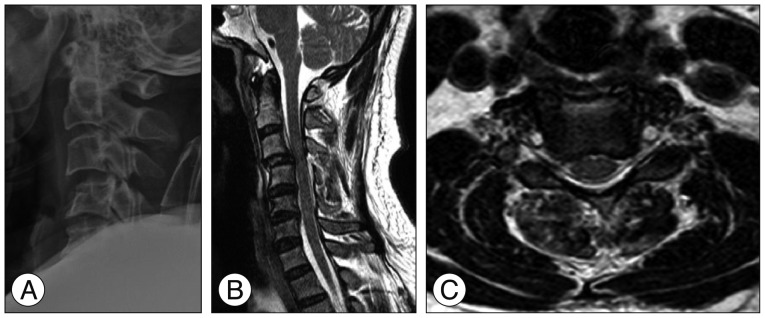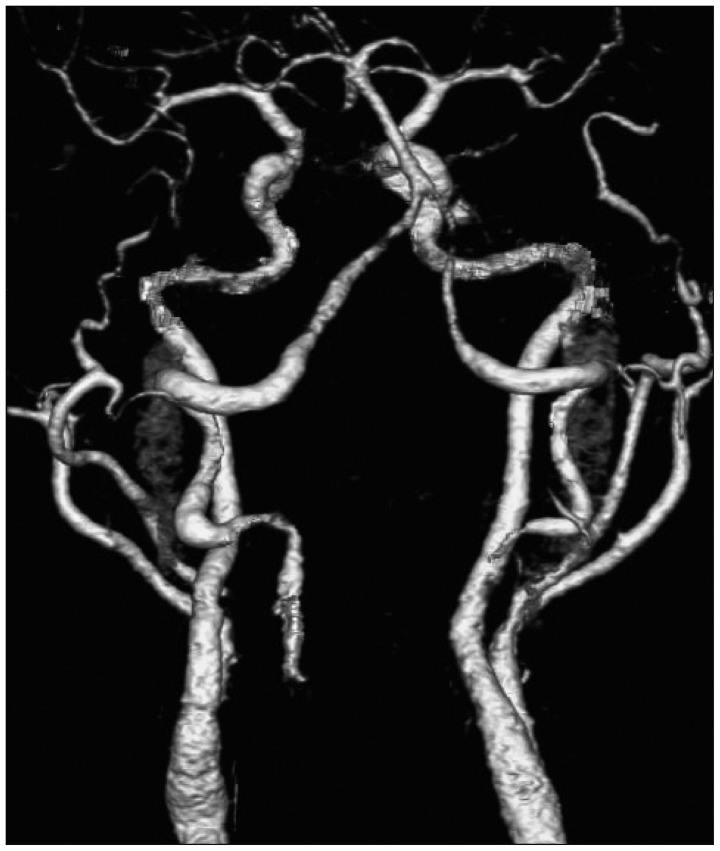J Korean Neurosurg Soc.
2014 Aug;56(2):141-145. 10.3340/jkns.2014.56.2.141.
Delayed Brain Infarction due to Bilateral Vertebral Artery Occlusion Which Occurred 5 Days after Cervical Trauma
- Affiliations
-
- 1Department of Neurosurgery, Kangwon National University Hospital, Chuncheon, Korea. dopaa@naver.com
- KMID: 1956517
- DOI: http://doi.org/10.3340/jkns.2014.56.2.141
Abstract
- Vertebral artery (VA) injuries usually accompany cervical trauma. Although these injuries are commonly asymptomatic, some result in vertebrobasilar infarction. The symptoms of VA occlusion have been reported to usually manifest within 24 hours after trauma. The symptoms of bilateral VA occlusions seem to be more severe and seem to occur with shorter latencies than those of unilateral occlusions. A 48-year-old man had a C3-4 fracture-dislocation with spinal cord compression that resulted from a traffic accident. After surgery, his initial quadriparesis gradually improved. However, he complained of sudden headache and dizziness on the 5th postoperative day. His motor weakness was abruptly aggravated. Radiologic evaluation revealed an infarction in the occipital lobe and cerebellum. Cerebral angiography revealed complete bilateral VA occlusion. We administered anticoagulation therapy. After 6 months, his weakness had only partially improved. This case demonstrates that delayed infarction due to bilateral VA occlusion can occur at latencies as long as 5 days. Thus, we recommend that patients with cervical traumas that may be accompanied by bilateral VA occlusion should be closely observed for longer than 5 days.
MeSH Terms
Figure
Cited by 2 articles
-
Delayed Infarction of Medullar and Cerebellum 3 Months after Vertebral Artery Injury with C1-2 Fracture: Case Report
Yunsuk Her, Suk Hyung Kang, Ilhom Abdullaev, Noah Kim
Korean J Neurotrauma. 2017;13(1):29-33. doi: 10.13004/kjnt.2017.13.1.29.Current Concepts in the Treatment of Traumatic C2 Vertebral Fracture : A Literature Review
Subum Lee, Junseok W Hur, Younggyu Oh, Sungjae An, Gi-Yong Yun, Jae-Min Ahn
J Korean Neurosurg Soc. 2024;67(1):6-13. doi: 10.3340/jkns.2023.0098.
Reference
-
1. Beletsky V, Nadareishvili Z, Lynch J, Shuaib A, Woolfenden A, Norris JW, et al. Cervical arterial dissection : time for a therapeutic trial? Stroke. 2003; 34:2856–2860. PMID: 14605328.2. Chung D, Sung JK, Cho DC, Kang DH. Vertebral artery injury in destabilized midcervical spine trauma; predisposing factors and proposed mechanism. Acta Neurochir (Wien). 2012; 154:2091–2098. discussion 2098. PMID: 22990630.
Article3. Deen HG Jr, McGirr SJ. Vertebral artery injury associated with cervical spine fracture. Report of two cases. Spine (Phila Pa 1976). 1992; 17:230–234. PMID: 1553595.4. Desouza RM, Crocker MJ, Haliasos N, Rennie A, Saxena A. Blunt traumatic vertebral artery injury : a clinical review. Eur Spine J. 2011; 20:1405–1416. PMID: 21674212.
Article5. Fink KR, Fink JR, Cohen WA. Cervical collaterals may protect against stroke after blunt vertebral artery injury. Emerg Radiol. 2011; 18:545–549. PMID: 21901449.
Article6. Friedman D, Flanders A, Thomas C, Millar W. Vertebral artery injury after acute cervical spine trauma : rate of occurrence as detected by MR angiography and assessment of clinical consequences. AJR Am J Roentgenol. 1995; 164:443–447. discussion 448-449. PMID: 7839986.
Article7. Galtés I, Borondo JC, Cos M, Subirana M, Martin-Fumadó C, Castellà J, et al. Traumatic bilateral vertebral artery dissection. Forensic Sci Int. 2012; 214:e12–e15. PMID: 21798679.
Article8. Golueke P, Sclafani S, Phillips T, Goldstein A, Scalea T, Duncan A. Vertebral artery injury--diagnosis and management. J Trauma. 1987; 27:856–865. PMID: 3612862.
Article9. Harrigan MR, Hadley MN, Dhall SS, Walters BC, Aarabi B, Gelb DE, et al. Management of vertebral artery injuries following non-penetrating cervical trauma. Neurosurgery. 2013; 72(Suppl 2):234–243. PMID: 23417194.
Article10. Hart DJ. To screen or not to screen : vertebral artery injuries in blunt cervical spine trauma. World Neurosurg. 2013; 80:309–310. PMID: 23103271.
Article11. Kim CH, Cho KT, Chung CK. Vertebral artery injury following blunt trauma to the cervical spine case report and literature review. J Korean Neurosurg Soc. 2004; 35:625–627.12. Lebl DR, Bono CM, Velmahos G, Metkar U, Nguyen J, Harris MB. Vertebral artery injury associated with blunt cervical spine trauma : a multivariate regression analysis. Spine (Phila Pa 1976). 2013; 38:1352–1361. PMID: 23574813.13. Medhkour A, Chan M. An unusually favorable outcome of bilateral vertebral arterial dissections : case report and review of the literature. J Trauma. 2005; 58:1285–1289. PMID: 15995485.
Article14. Mimata Y, Murakami H, Sato K, Suzuki Y. Bilateral cerebellar and brain stem infarction resulting from vertebral artery injury following cervical trauma without radiographic damage of the spinal column : a case report. Skeletal Radiol. 2014; 43:99–105. PMID: 24061492.
Article15. Mitha AP, Kalb S, Ribas-Nijkerk JC, Solano J, McDougall CG, Albuquerque FC, et al. Clinical outcome after vertebral artery injury following blunt cervical spine trauma. World Neurosurg. 2013; 80:399–404. PMID: 22850281.
Article16. Miyachi S, Okamura K, Watanabe M, Inoue N, Nagatani T, Takagi T. Cerebellar stroke due to vertebral artery occlusion after cervical spine trauma. Two case reports. Spine (Phila Pa 1976). 1994; 19:83–88. PMID: 8153813.
Article17. Mueller CA, Peters I, Podlogar M, Kovacs A, Urbach H, Schaller K, et al. Vertebral artery injuries following cervical spine trauma : a prospective observational study. Eur Spine J. 2011; 20:2202–2209. PMID: 21717238.
Article18. Muratsu H, Doita M, Yanagi T, Sekiguchi K, Nishida K, Tomioka M, et al. Cerebellar infarction resulting from vertebral artery occlusion associated with a Jefferson fracture. J Spinal Disord Tech. 2005; 18:293–296. PMID: 15905778.19. Parent AD, Harkey HL, Touchstone DA, Smith EE, Smith RR. Lateral cervical spine dislocation and vertebral artery injury. Neurosurgery. 1992; 31:501–509. PMID: 1407430.
Article20. Schneck M, Simionescu M, Bijari A. Bilateral vertebral artery dissection possibly precipitated in delayed fashion as a result of roller coaster rides. J Stroke Cerebrovasc Dis. 2008; 17:39–41. PMID: 18190821.
Article21. Six EG, Stringer WL, Cowley AR, Davis CH Jr. Posttraumatic bilateral vertebral artery occlusion : case report. J Neurosurg. 1981; 54:814–817. PMID: 7017076.22. Taneichi H, Suda K, Kajino T, Kaneda K. Traumatically induced vertebral artery occlusion associated with cervical spine injuries : prospective study using magnetic resonance angiography. Spine (Phila Pa 1976). 2005; 30:1955–1962. PMID: 16135985.
Article
- Full Text Links
- Actions
-
Cited
- CITED
-
- Close
- Share
- Similar articles
-
- Occlusion of Vertebral Artery and Cerebral Infarction after Cervical Spine Fracture: A Case Report
- Delayed Infarction of Medullar and Cerebellum 3 Months after Vertebral Artery Injury with C1-2 Fracture: Case Report
- Three cases of posterior circulation infarction related with cervical manipulation or trauma
- Cervical Spinal Cord Infarction Presenting as Chest Pain in Patients with Acute Cerebellar Infarction
- Cerebello-brain stem Infarction following Tearing of Vertebral Artery combined with Cervical Spine Fracture






